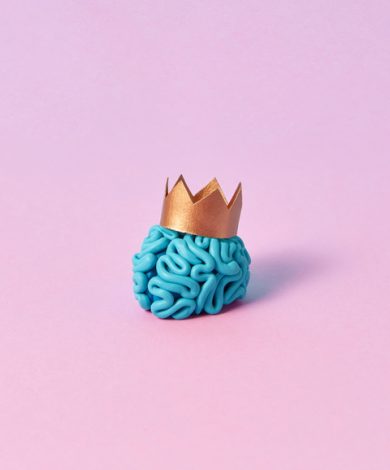Pain: it’s the sensation us humans want to avoid at all costs, because… well, it…
Body
Healing Adrenal Fatigue: Complete The Stress Cycle & Find Deep Rest. Finally.
August 16, 2021 • By Anne Omland

“I’m so effing tired.” These four words have likely rolled out of your mouth more times than you can count. And that makes complete sense because motherhood is… exhausting.
A changing body. A new identity. Shifting family dynamics. Juggling what feels like a million responsibilities. Endlessly tending to the baby. Carrying the feelings that come along with all of it. All of this places a serious amount of stress and frenetic energy on your shoulders. Too much.
But, when is fatigue par for the course and when is it something to flag as needing more attention?
What we don’t often realize is that living in survival mode — in the fight or flight response where our bodies are pumping out cortisol and adrenaline all the time — is a huge source of depletion. Leaving us exhausted on top of already being exhausted.
Leaving so many women unknowingly walking around with adrenal fatigue, a prolonged hormonal imbalance caused by chronic stress.
The good news is that you can do something about this right now. But before I share how, it’s important to know how the adrenals function.
The adrenal glands are a pair of walnut-sized, endocrine glands located on top of your kidneys. They produce a number of hormones and chemicals, notably cortisol and adrenaline.
The stress hormones.
This is an important part of the hypothalamus-pituitary-adrenal-axis (say that three times fast) or HPA-axis. This axis communicates to your brain what’s going on around you and your physical reaction to what’s going on around you. Adrenal fatigue occurs when your small but powerful adrenal glands are overworked leaving the system unstable.
The HPA-axis is like a 3-legged stool that balances your hormone, immune, and nervous systems. And when the stool becomes imbalanced (between the hypothalamus, pituitary gland, and adrenals), you feel the resulting lack of stability.
This is the most common hormonal imbalance for women, often triggered by birth and left undiagnosed for years. It’s often written off as exhaustion because …well, we’re moms. And we are stressed out.
Stress tells our brain to tell the pituitary gland to tell the adrenals to make and send stress hormones to your body. When stress strikes, and you start secreting more cortisol and adrenaline, your heart beats faster, your breathing changes, your pupils dilate, and your mind becomes hyper-vigilant. Yikes! Typically, this stress response should only occur when your life is at stake. And only last the short period of time you’re in danger before you reach a safe space.
The intense, prolonged stress we experience postpartum like sleep deprivation, anxiety, lack of nourishment and support, can put your adrenals in overdrive. Because the stress-inducing inputs are relentless, our brain can’t find a safe space so it acts like we are constantly in danger. Putting us in a chronic state of stress. Your adrenals just keep pumping out more and more cortisol making that stool (the HPA-axis) we were talking about earlier, unstable.
So what does adrenal fatigue look like? How is it different from classic, run of the mill fatigue?
It looks like…
- “Tired and wired.” This classic indicator of adrenal fatigue feels similar to anxiety with scattered thoughts, trouble sleeping, but no energy to do anything besides try to get some sleep.
- Increased anxiety and irritability. A short fuse.
- Food cravings. Especially carbs, fat, and salt.
- Feeling energized one day and making tons of plans only to cancel them.
- Spurts of high energy that take you days to recover from.
- Feeling like you’re getting sick, low libido, compromised memory, and mental fogginess.
- Depression. No energy, trouble sleeping, no amount of rest is enough.
- Your digestion gets…messy.
People are quick to suggest self-care as the magical solution to everything. Telling someone with adrenal fatigue to commit to self-care is like telling someone who is in the middle of a panic attack to “relax.” In order to actually address and relieve adrenal fatigue, we need to address the cause of chronic stress instead of treating only the symptoms.
The HPA-axis is a beautifully orchestrated neurobiological response that protects us from danger. We need to complete the stress response cycle and return to balance. There is a beginning, middle, and end to this cycle and it’s when we get stuck in the middle that we have a problem.
BEGINNING: Perceived threat. Could be a saber toothed tiger trying to eat you alive or someone trying to kiss your baby’s face after you told them not to.
MIDDLE: HPA axis activated full throttle cueing stress so that you DO something about the perceived threat. Like run away or say you need to feed your baby and take them away from the rogue kisser.
END: Notify your body that you are out of danger and safe. This is the part that is often left out.
Without the clear green light that we are safe our body keeps pumping cortisol and adrenaline. We stay in the middle because clearly we’re not safe yet and need to keep running from the perceived threat. And our brain really doesn’t distinguish between a saber toothed tiger or a disrespectful relative.
Ok, it’s not all bad news. Now that we have some clarity around what adrenal fatigue is and why it happens, let’s move toward evidence-based ways to complete the stress cycle that don’t include running away from your family.
Short bursts of cardio
This simulates you running away from the big cat and can be anything from jumping jacks, dancing, or marching in place. Be mindful of your pelvic floor which you can read about here.
Tell someone what you’re experiencing
Talking about what is happening and how it is affecting you grounds you in this space where the threat is no longer present. Sharing your story is so powerful that I wrote this article about it.
Awkwardly long hug
Like 20 seconds or so. Allow your nervous system to coregulate with the person you are hugging. This will let your brain know you are safe.
Rest
For real. Practice Yoga Nidra, meditate, nap. This allows your nervous system to work through the stress cycle and return to a calm, rest, and digest, parasympathetic state. THEN you can start to consider self-care.
Remember, you’re not meant to suffer or live in a perpetual survival mode. While we are often led to believe that motherhood equals martyrdom and that pain is just part of the journey, that is not the truth. You can feel better — and it starts with understanding your body and what you can do to support it.
Looking for a practice that helps to complete the stress cycle and calm your nervous system? Check out these articles on TRE and Tapping. Oh, and remember to breathe 😉

